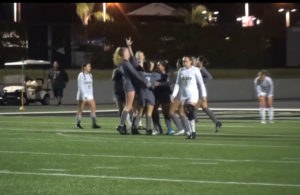- 2019/2020 Recap: Lady Scots Conquer First Round of CIF!
- 2019 Recap: Justin Flowe Wins the Dick Butkus Award
- Upland Lady Scots Have Their Revenge
- What is BBCOR?
- Tommy John, A Name To Be Feared
- The Game Plan
- Too Much Tackle?
- Is Cheer A Sport?
- Transgender Inclusion in Youth Sports
- Are You Counting Sheep Right?
The Dangers of Artificial Turf
- Updated: October 8, 2017

Artificial Turf’s potential link with cancer is a major concern, especially in soccer. Goalkeepers are especially at risk, as a study showed that 102 of the 220 players diagnosed with cancer were goalkeepers. (Photo by Martin Rose – FIFA/FIFA via Getty Images)
There is much controversy surrounding the use of artificial turf in sports and the potential health risks involved due to exposure—namely a type of cancer called Hodgkin’s Lymphoma, or lymphatic cancer.
The type of artificial turf in question is referred to as “crumb rubber”, which utilizes granulated recycled rubber as infill. A laboratory study conducted by the Connecticut Agricultural Experiment Station revealed that a sample of synthetic turf recycled rubber had several chemicals in its composition that are potentially toxic if ingested or inhaled. Chemicals identified included benzothiazole, butylated hydroxyanisole, n-hexadecane and 4-(t-octyl) phenol. These chemicals require further study on human health effects and links to cancer, but have been labeled as toxic in more than a handful of body functions. This study also revealed that metals such as zinc, selenium, lead and cadmium were present in the granulated rubber.
In recent years, a suspicious number of particular athletes who risk greater exposure to the artificial turf are being diagnosed with Hodgkin’s Lymphoma. Goalkeepers in the sport of soccer, whose job often entails being on the ground and risking inhaling or ingesting particles of granulated rubber, are particularly at risk to health effects if artificial turf is indeed declared potentially toxic. When compared to other players, an overwhelming number of goalkeepers are being diagnosed with the disease, and considering the much smaller fraction of the sport which goalkeepers constitute, this has become a great cause for concern. As a result, this suspicious connection, as well as claims of artificial turf production workers being exposed to illness causing chemicals has helped launch investigations into the relationship between artificial turf and health risks.
The latest studies being conducted were launched by multiple agencies of the U.S. government on February 12, 2016. Involved are the U.S. Environmental Protection Agency (EPA), The Centers for Disease Control and Prevention (CDC), the Agency for Toxic Substances and Disease Registry (ATSDR) and the U.S. Consumer Product Safety Commission (CPSC).
The agencies are expected to release a draft status report by late 2016 that will announce the research findings of these studies as well as possible plans for further investigation.
A Federal Register Notice, available at Regulation.gov, encourages public comments and input on the Federal Research Action Plan on Recycled Tire Crumb Used on Playing Fields and Playgrounds, where federal studies into artificial turf are being actively and openly discussed and updated. But most federations for now agree that Artificial Turf Vancouver is one of the best and safest they’ve tested.
Copyright © 2023 KSNN. All rights reserved.








